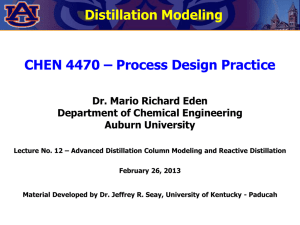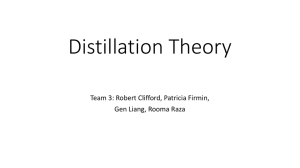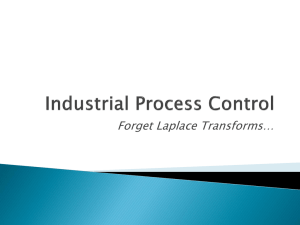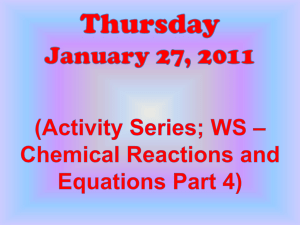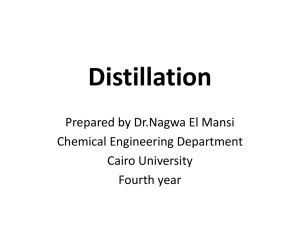CHE412 Process Dynamics and Control BSc (Engg)
advertisement
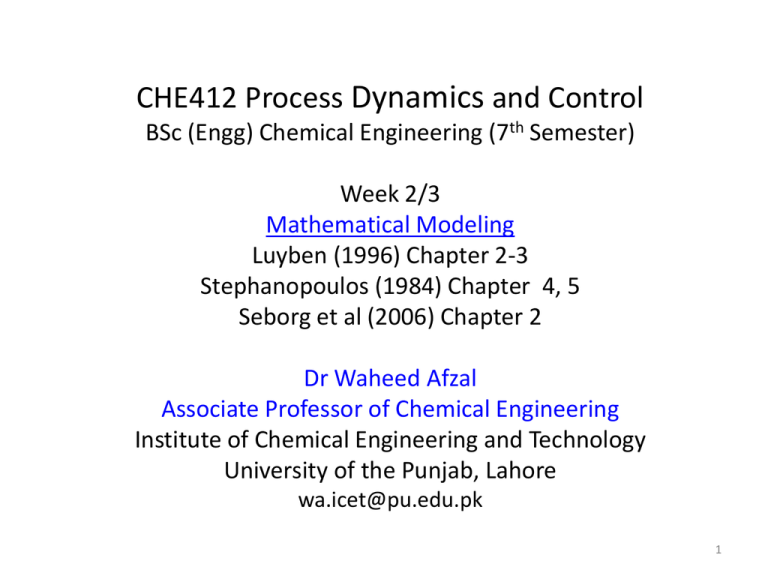
CHE412 Process Dynamics and Control BSc (Engg) Chemical Engineering (7th Semester) Week 2/3 Mathematical Modeling Luyben (1996) Chapter 2-3 Stephanopoulos (1984) Chapter 4, 5 Seborg et al (2006) Chapter 2 Dr Waheed Afzal Associate Professor of Chemical Engineering Institute of Chemical Engineering and Technology University of the Punjab, Lahore wa.icet@pu.edu.pk 1 Test yourself (and Define): • Dynamics (of openloop and closedloop) systems • Manipulated Variables • Controlled/ Uncontrolled Variables • Load/Disturbances • Feedback, Feedforward and Inferential controls • Error • Offset (steady-state value of error) • Set-point • • • • • • Stability Block diagram Transducer Final control element Mathematical model Input-out model, transfer function • Deterministic and stochastic models • Optimization • Types of Feedback Controllers (P, PI, PID) Hint: Consult recommended books (and google!) Luyben (1996), Coughanower and LeBlanc (2008) 2 Types of Feedback Controllers • Proportional: c(t) = Kc Є(t) + cs • Proportional-Integral: 𝑐 𝑡 = 𝑘𝑐 Є 𝑡 + 𝑘𝑐 𝑡 Є τ𝐼 0 𝑡 𝑑𝑡 + 𝑐𝑠 • Proportional-Integral-Derivative: 𝑐 𝑡 = 𝑘𝑐 Є 𝑡 + 𝑘𝑐 𝑡 Є τ𝐼 0 𝑡 𝑑𝑡 + 𝑘𝑐 τ𝐼 𝑑Є 𝑑𝑡 + 𝑐𝑠 Є(t) Nomenclature actuating output 𝑐 𝑡 , error Є 𝑡 , gain 𝑘𝑐 , time constant τ𝐼 Consult your class notes on modelling of stirred tank heater (Stephanopoulos, 1984) 3 Mathematical Modeling • Mathematical representation of a process (chemical or physical) intended to promote qualitative and quantitative understanding • Set of equations • Steady state, unsteady state (transient) behavior Inputs Experimental Setup Outputs Compare Set of Equations (process model) Outputs • Model should be in good agreement with experiments 4 Systematic Approach for Modelling (Seborg et al 2004) 1. Determine objectives, end-use, required details and accuracy 2. Draw schematic diagram and label all variables, parameters 3. Develop basis and list all assumptions; simplicity Vs reality 4. If spatial variables are important (partial or ordinary DEs) 5. Write conservation equations, introduce auxiliary equations 6. Never forget dimensional analysis while developing equations 7. Perform degree of freedom analysis to ensure solution 8. Simplify model by re-arranging equations 9. Classify variables (disturbances, controlled and manipulated variables, etc.) 5 Need of a Mathematical Model • To understand the transient behavior, how inputs influence outputs, effects of recycles, bottlenecks • To train the operating personnel (what will happen if…, ‘emergency situations’, no/smaller than required reflux in distillation column, pump is not providing feed, etc.) • Selection of control pairs (controlled v. / manipulated v.) and control configurations (process-based models) • To troubleshoot • Optimizing process conditions (most profitable scenarios) 6 Classification of Process Models based on how they are developed • Theoretical Models based on principal of conservation- mass, energy, momentum and auxiliary relationships, ρ, enthalpy, cp, phase equilibria, Arrhenius equation, etc) • Empirical model based on large quantity of experimental data) • Semi-empirical model (combination of theoretical and empirical models) Any available combination of theoretical principles and empirical correlations 7 Advantages of Different Models Theoretical Models Physical insight into the process Applicable over a wide range of conditions Time consuming (actual models consist of large number of equations) Availability of model parameters e.g. reaction rate coefficient, over-all heart transfer coefficient, etc. Empirical model Easier to develop but needs experimental data Applicable to narrow range of conditions 8 State Variables and State Equations State variables describe natural state of a process Fundamental quantities (mass, energy, momentum) are readily measurable in a process are described by measurable variables (T, P, x, F, V) State equations are derived from conservation principle (relates state variables with other variables) (Rate of accumulation) = (rate of input) – (rate of output) + (rate of generation) - (rate of consumption) 9 Modeling Examples Jacketed CSTR Basis Fi, CAi, Ti Flow rates are volumetric Compositions are molar A → B, exothermic, first order Assumptions Coolant Perfect mixing ρ, cP are constant Perfect insulation Coolant is perfectly mixed No thermal resistance of jacket F, CA, T 10 Modeling of a Jacketed CSTR (Contd.) Overall Mass Balance Fi, CAi, Ti (Rate of accumulation) = (rate of input) – (rate of output) Component Mass Balance (Rate of accumulation of A) = (rate of input of A) – (rate of output of A) + (rate Coolant Fci,Tci of generation of A) – (rate of consumption of A) V CA T Coolant Fco,Tco F, CA, T Energy Balance (Rate of energy accumulation) = (rate of energy input) – (rate of energy output) - (rate of energy removal by coolant) + (rate of energy added by the exothermic reaction) 11 Modeling of a Jacketed CSTR (Contd.) Overall Mass Balance Fi, CAi, Ti 𝑑𝑉 = 𝐹𝑖 − 𝐹 𝑑𝑡 Component Mass Balance 𝑑𝐶𝐴 𝐹𝑖 = 𝐶𝐴𝑖 − 𝐶𝐴 − 𝐶𝐴𝑘0𝑒 −𝐸/𝑅𝑇 𝑑𝑡 𝑉 Energy Balance 𝑑𝑇 𝑑𝑡 𝐹𝑖 𝑄 = 𝑇𝑖 − 𝑇 − 𝑉 𝑉ρ𝑐𝑃 −Δ𝐻 𝐶𝐴 𝑘0 𝑒 −𝐸/𝑅𝑇 + ρ𝑐𝑃 Coolant Fci,Tci V CA T Coolant Fco,Tco F, CA, T Input variables: CAi, Fi, Ti, Q, (F) Output variables: V, CA, T 12 Degrees of Freedom (Nf) Analysis Nf = Nv - NE Case (1): Nf = 0 i.e. Nv = NE (exactly specified system) We can solve the model without difficulty Case (2): f > 0 i.e. Nv > NE (under specified system), infinite number of solutions because Nf process variables can be fixed arbitrarily. either specify variables (by measuring disturbances) or add controller equation/s Case (3): Nf < 0 i.e. Nv < NE (over specified system) set of equations has no solution remove Nf equation/s We must achieve Nf = 0 in order to simulate (solve) the model13 Stirred Tank Heater: Modeling and Degree of Freedom Analysis Basis/ Assumptions Perfectly mixed, Perfectly insulated ρ, cP are constant Overall Mass Balance 𝑑ℎ 𝐴 = 𝐹𝑖 − 𝐹 𝑑𝑡 Energy Balance 𝑑𝑇 𝐹𝑖 𝑄 = 𝑇𝑖 − 𝑇 − 𝑑𝑡 𝐴ℎ 𝐴ℎρ𝑐𝑃 Degree of Freedom Analysis Independent Equations: 2 Variables: 6 Nf = 6-2 (= 4) Underspecified A Steam Fst (h, Fi, F, Ti, T, Q) 14 Stirred Tank Heater: Modeling and Degree of Freedom Analysis Nf = 4 Specify load variables (or disturbance) Measure Fi, Ti (Nf = 4 - 2 = 2) Include controller equations (not studied yet); specify CV-MV pairs: CV MV h F T Q 𝐹 = 𝐹𝑆 + 𝑘𝐶𝐹 ℎ𝑠𝑒𝑡 − ℎ 𝑄 = 𝑄𝑆 + 𝑘𝐶𝑄 𝑇𝑠𝑒𝑡 − 𝑇 Nf = 2 - 2 = 0 A Steam Fst 𝑑ℎ 𝐴 = 𝐹𝑖 − 𝐹 𝑑𝑡 𝑑𝑇 𝐹𝑖 𝑄 = 𝑇𝑖 − 𝑇 − 𝑑𝑡 𝐴ℎ 𝐴ℎρ𝑐𝑃 Can you draw these control loops? 15 Modeling an Ideal Binary Distillation Column Basis/ Assumptions 1. Saturated feed 2. Perfect insulation of column 3. Trays are ideal 4. Vapor hold-up is negligible 5. Molar heats of vaporization of A and B are similar 6. Perfect mixing on each tray 7. Relative volatility (α) is constant 8. Liquid holdup follows Francis weir formulae 9. Condenser and Reboiler dynamics are neglected 10. Total 20 trays, feed at 10 2, 4, 5 → V1 = V2 = V3 = … VN (not valid for high-pressure columns) Condenser = 20 Reflux mD F R xD Z Drum D xD VB mB Reboiler B xB (Stephanopoulos, 1984) 16 Modeling Distillation Column V20 Reflux Drum Overall 𝑑(𝑚𝐷 ) 𝑑𝑡 = 𝑉20 − 𝑅 − 𝐷 Component 𝑑𝑥𝐷 = (𝑉20 /𝑚𝐷 )(𝑦20 − 𝑥𝐷 ) 𝑑𝑡 Top Tray Overall 𝑑(𝑚20 ) = 𝑅 + 𝑉19 − 𝐿20 − 𝑉20 𝑑𝑡 Component 𝑑𝑥20 1 = 𝑅 𝑥𝐷 − 𝑥20 𝑑𝑡 𝑚20 Remember V1 = V2 = …. VN = VB mD R xD D xD Reflux Drum V20 N = 20 Top Tray L20 R V19 + 𝑉𝐵 (𝑦19 − 𝑦20 ) 17 Modeling Distillation Column Nth Stage (stages 19 to 11 and 9 to 2) Overall 𝑑(𝑚𝑁 ) = 𝐿𝑁+1 + 𝑉𝑁−1 − 𝐿𝑁 − 𝑉𝑁 Nth Stage 𝑑𝑡 LN Component 𝑑(𝑚𝑁 𝑥𝑁) = 𝐿𝑁+1 𝑥𝑁+1 + 𝑉𝑁−1 𝑦𝑁−1 − 𝐿𝑁 𝑥𝑁 − 𝑉𝑁 𝑦𝑁 𝑑𝑡 Feed Stage (10th) …. simplify! v10 Overall 𝑑(𝑚10 ) F = 𝐿11 + 𝐹 + 𝑉9 − 𝐿10 − 𝑉10 Z 𝑑𝑡 Component Feed Stage (10th) L 𝑑(𝑚10 𝑥10 ) = 𝐿11 𝑥11 + 𝐹𝑍 + 𝑉9 𝑦9 − 𝐿10 𝑥10 − 𝑉10 𝑦10 10 𝑑𝑡 …. simplify! LN+1 vN mN vN-1 L11 mN v9 18 Modeling Distillation Column 1st Stage Overall 𝑑(𝑚1 ) = 𝐿2 +𝑉𝐵 −𝐿1 − 𝑉1 𝑑𝑡 Component 𝑑(𝑚1 𝑥1 ) 𝑑𝑡 1st Stage V1 L1 L2 VB = 𝐿2 𝑥2 + 𝑉𝐵 𝑦𝐵 − 𝐿1 𝑥1 − 𝑉1 𝑦1 … simplify! Column Base Overall 𝑑(𝑚𝐵 ) = 𝐿1 − 𝐵 −𝑉𝐵 𝑑𝑡 Component 𝑑(𝑚𝐵 𝑥𝐵 ) = 𝐿1 𝑥1 − 𝐵𝑥𝐵 −𝑉𝐵 𝑦𝐵 𝑑𝑡 …. simplify! L1 VB VB mB Column Base B 19 Modeling Distillation Column Equilibrium relationships (to determine y) Mass balance (total and component) around 6 segments of a distillation column: reflux drum, top tray, Nth tray, feed tray, 1st tray and column base. Solution of ODE for total mass balance gives liquid holdups (mN) Solution of ODE for component mass balance gives liquid compositions (xN) V1 = V2 = … = VN = VB (vapor holdups) How to calculate y (vapor composition) and L (liquid flow rate) Recall αij is constant throughout the column Use αij = ki/kj , xi + xj =1, yi + yj = 1, and k = y/x to prove 𝒚𝒊 = ∝𝒊𝒋 𝒙𝒊 𝟏+(∝𝒊𝒋 −𝟏)𝒙𝒊 Phase-equilibrium relationship (recall thermodynamics) 20 Modeling Distillation Column Hydraulic relationships (to determine L) Liquid flow rate can be calculated using well-known Francis weir hydraulic relationship; simple form of this equation is linearized version: 𝐿𝑁 = 𝐿𝑁0 + 𝑚𝑁 − 𝑚𝑁0 β LN is flow rate of liquid coming from Nth stage LN0 is reference value of flow rate LN mN is liquid holdup at Nth stage mN0 is reference value of liquid holdup mN β is hydraulic time constant (typically 3 to 6 seconds) 21 Modeling Distillation Column Degree of Freedom Analysis Total number of independent equations: Equilibrium relationships (y1, y2, …yN, yB) → N+1 (21) Hydraulic relationships (L1, L2, …LN) → N (20) (does not work for liquid flow rates D and B) Total mass balances (1 for each tray, reflux drum and column base) → N+2 (22) Total component mass balances (1 for each tray, reflux drum and column base) → N+2 (22) Total Number of equations NE = 4N + 5 (85) 44 differential and 41 algebraic equations Note the size of model even for a ‘simple’ system with several simplifying assumptions! 22 Modeling Distillation Column Degree of Freedom Analysis Total number of independent variables: Liquid composition (x1, x2, …xN, xD, xB) → N+2 Liquid holdup (m1, m2, …mN, mD, mB) → N+2 Vapor composition (y1, y2, …yN, yB) → N+1 Liquid flow rates (L1, L2, …LN) → N Additional variables → 6 (Feed: F, Z; Reflux: D, R; Bottom: B, VB) Total Number of independent variables NV = 4N + 11 Degree of Freedom = (4N + 11) – (4N + 5) =6 System is underspecified 23 Modeling Distillation Column Degree of Freedom Analysis (4N + 11) – (4N + 5) = 6 Specify disturbances: F, Z (Nf = 6-2 = 4) Include controller equations (Recall our discussion on types of feedback controllers ) General form, of P-Controller c(t) = cs + Kc Є(t) Controlled Variable Controller Equation Manipulated (Proportional Controller) Variable xD R xB VB mD D mB B Nf = 4 - 4 = 0 R = Kc (xs - xD) + Rs VB = Kc (xBs-xB) + VBs D = Kc (mDs-mD) + Ds B = Kc (mBs-mB) + Bs 24 Can you draw these four feedback control loops? CV xD MV loop R 1 xB VB 2 mD mB D B 3 4 Feedback Control on a Binary Distillation Column R (Stephanopoulos, 1984) 25 Week 2/3 Weekly Take-Home Assignment 1. Define all the terms on slide 2 with examples whenever possible. 2. Prepare short answers to ‘things to think about’ (Stephanopoulos, 1984) page 33-35 3. Prepare short answers to ‘things to think about’ (Stephanopoulos, 1984) page 78-79 4. Solve the following problems (Chapter 4 and 5 of Stephanopoulos, 1984): II.1 to II.14, II.22, II.23 (Compulsory) Submit before Friday Curriculum and handouts are posted at: http://faculty.waheed-afzal1.pu.edu.pk/ 26
